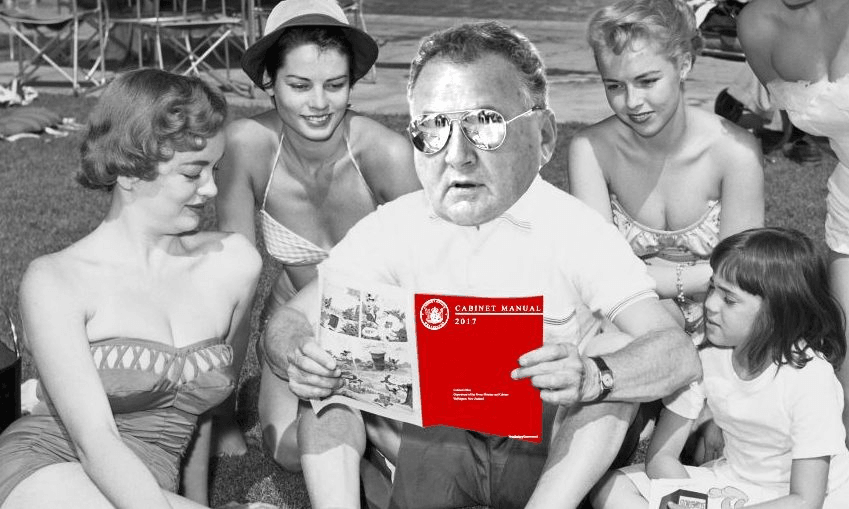The prime minister says her misbehaving coalition cabinet minister is taking the Cabinet Manual away to study. Is it the perfect page-turner beach read? Madeleine Chapman finds out.
This story was published in October 2019.
Is there anything better than reading a trashy thriller while on holiday? For Shane Jones, only one thing: Threatening political utu on his enemies (aka the small group of forestry industry representatives who complained that he was electioneering at an awards night they attended).
Questioned about the New Zealand First MP’s blurring of his ministerial and partisan roles, Jacinda Ardern told media that the solution was a bit of holiday reading. “Minister Jones is about to take a short break, a holiday, over the recess, and we’ve agreed that he’ll take the Cabinet Manual with him,” she said.
What is this Cabinet Manual, and should it be on your list of holiday reads? I sat down poolside (metaphorically) and set about finding out.
As the “primary authority on the conduct of Cabinet government in New Zealand, the Cabinet Manual “provides guidance rather than prescribing rules” for those in government.
Clocking in at 172 A4 pages (think a Jack Reacher novel for size), the book opens strongly.
“A constitution: What is it?”
Present a question, get the reader thinking, make them realise they’ve never once thought about what a constitution is.
“The Governor-General has the power to summon, prorogue and dissolve Parliament.”
After 25 years of being blissfully unaware of the existence of the word “prorogue”, it’s suddenly everywhere. It’s in the papers, it’s online, it’s at the dinner table, it’s in the Cabinet Manual. Prorogue is the word of the year. And yet 90% of the people who have used it (myself included) still don’t fully know what it means.
The Cabinet Manual takes its time introducing characters up the top. It’s an unorthodox approach but it works. The Queen, the Governor-General, the Prime Minister. All introduced in great detail with their responsibilities outlined. For example, “the Prime Minister has an important role in maintaining and coordinating the government by overseeing the government’s general policy direction”.
Some readers may consider this to be redundant, but a reminder that the prime minister’s job is important is always welcome.
Ministers, meanwhile, “have a political role in maintaining government stability…” It’s a great lead in to what could be a chapter packed with tension. Instead the book continues on to yet another list. It’s a missed opportunity to provide examples of how this statement could be applied in real life, in order to create a world for the reader. A world, for example, where a minister might claim credit for the sinking of a policy floated by his party’s coalition partner. Or where a minister might go against the wishes of the prime minister and label a government initiative “Work for the Dole” when that’s the very label the prime minister wanted to avoid. Or where a minister told the chairman of New Zealand’s largest enterprise to literally leave town, and then attempted to dictate the actions of New Zealand’s national carrier.
The unnamed author of the Cabinet Manual would have done well to hold the reader’s hands through anecdotes like this because without them, the prose feels just a little stunted.
The climax of the Cabinet Manual comes early in the chapter on conflict(s of interest). It begins: “Ministers must ensure that any conflicts of interest are addressed promptly…If in doubt about the appropriate course of action, Ministers should consult the Prime Minister or the Secretary of the Cabinet.”
The manual, however, is once again lacking in real life examples. It doesn’t draw the reader in as well as it might. It could, for example, have told a completely hypothetical story of a man named, for example, Shane Jones. And this Shane Jones fellow was a minister with a declared conflict of interest in relation to an application for funding from a regional growth fund he was overseeing. What would happen if Jones, say, sat in on a meeting determining the outcome of this application?
Or, it could tell a different hypothetical anecdote about a minister named, for example, Shane Jones, warning the New Zealand Transport Agency about “economic implications” if NZTA revoked a certain company’s transport service license. The twist? This Shane Jones character is related to the company’s managing director and accepted a donation from him in 2008. What would happen then?
According to the Cabinet Manual, if this Jones character’s conflicts were “substantial and enduring”, the next course of action would be to “consider a permanent change to some or all of the Minister’s portfolio responsibilities.” Thrilling!
But the Cabinet Manual doesn’t offer such exciting hypotheticals, nor does it present much in the way of a look to the future, where such courses of action might be undertaken against the Shane Jones protagonist. Perhaps that will be covered in the sequel.
TL;DR: “Ministers are expected to act lawfully and to behave in a way that upholds, and is seen to uphold, the highest ethical standards. This includes exercising a professional approach and good judgement in their interactions with the public and officials, and in all their communications, personal and professional.”

